Perth CBD Office Building Cleaning Services Procurement Plan
VerifiedAdded on 2021/04/21
|18
|4570
|54
Report
AI Summary
This report outlines a comprehensive procurement plan for cleaning services in a 5-story office building located in the Perth Central Business District (CBD). The plan encompasses a vision statement emphasizing a clean and sterile work environment to enhance employee productivity and improve the organization's image. The report includes a detailed market analysis of the cleaning service industry, cost analysis based on job size and required services, and financial considerations for procurement. It specifies the procurement policies, contract types, and external factors impacting the industry. The report also presents a scored selection criteria for choosing a contractor, a timeline for the procurement process, and a project timeline. A procurement risks register identifies potential risks. The report also includes a scope of work detailing the cleaning service requirements, key performance indicators (KPIs) for measuring contractor performance, and a communication management plan. This report provides a framework for organizations to procure and manage cleaning services effectively, ensuring a clean and efficient work environment.
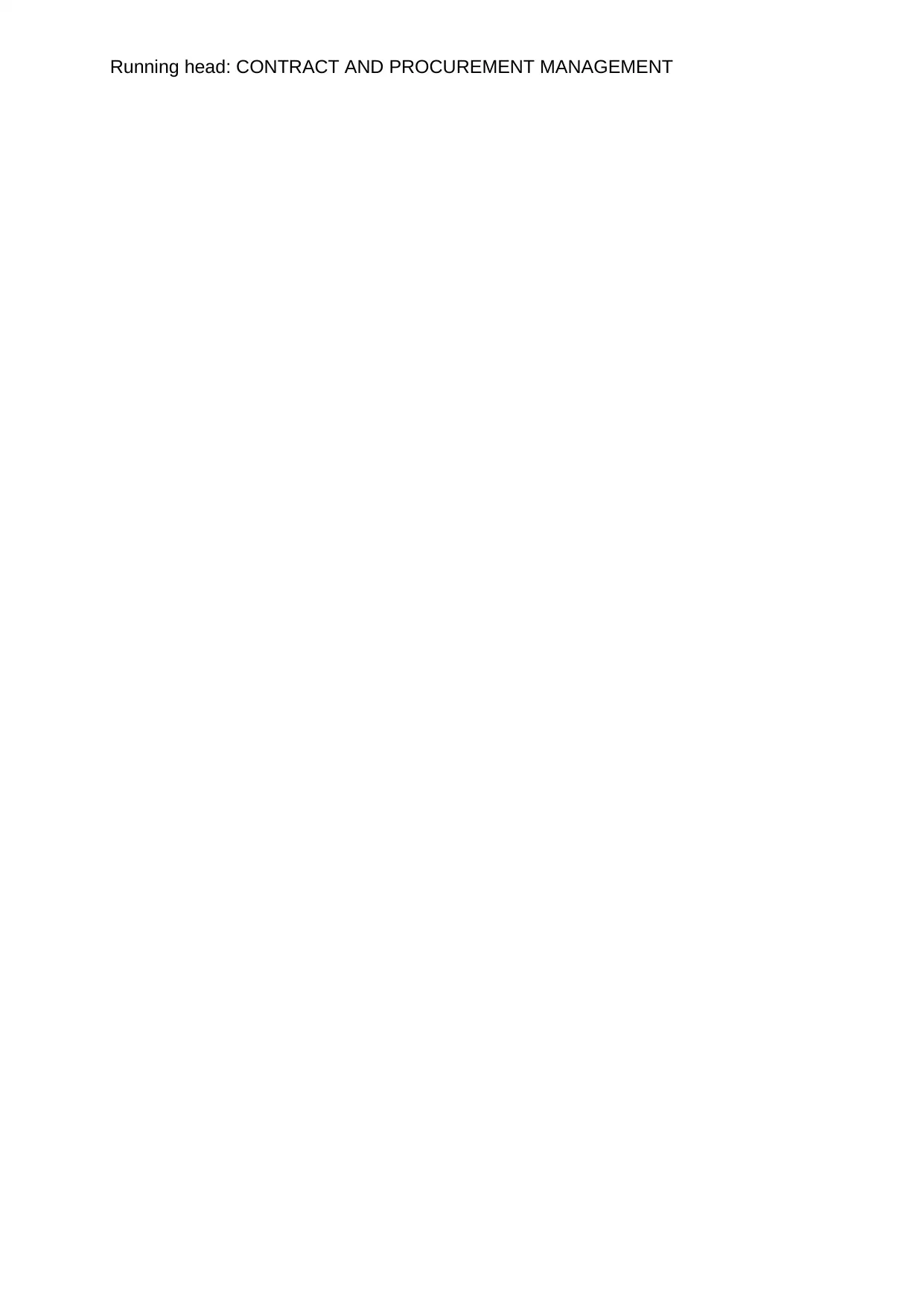
Running head: CONTRACT AND PROCUREMENT MANAGEMENT
Paraphrase This Document
Need a fresh take? Get an instant paraphrase of this document with our AI Paraphraser
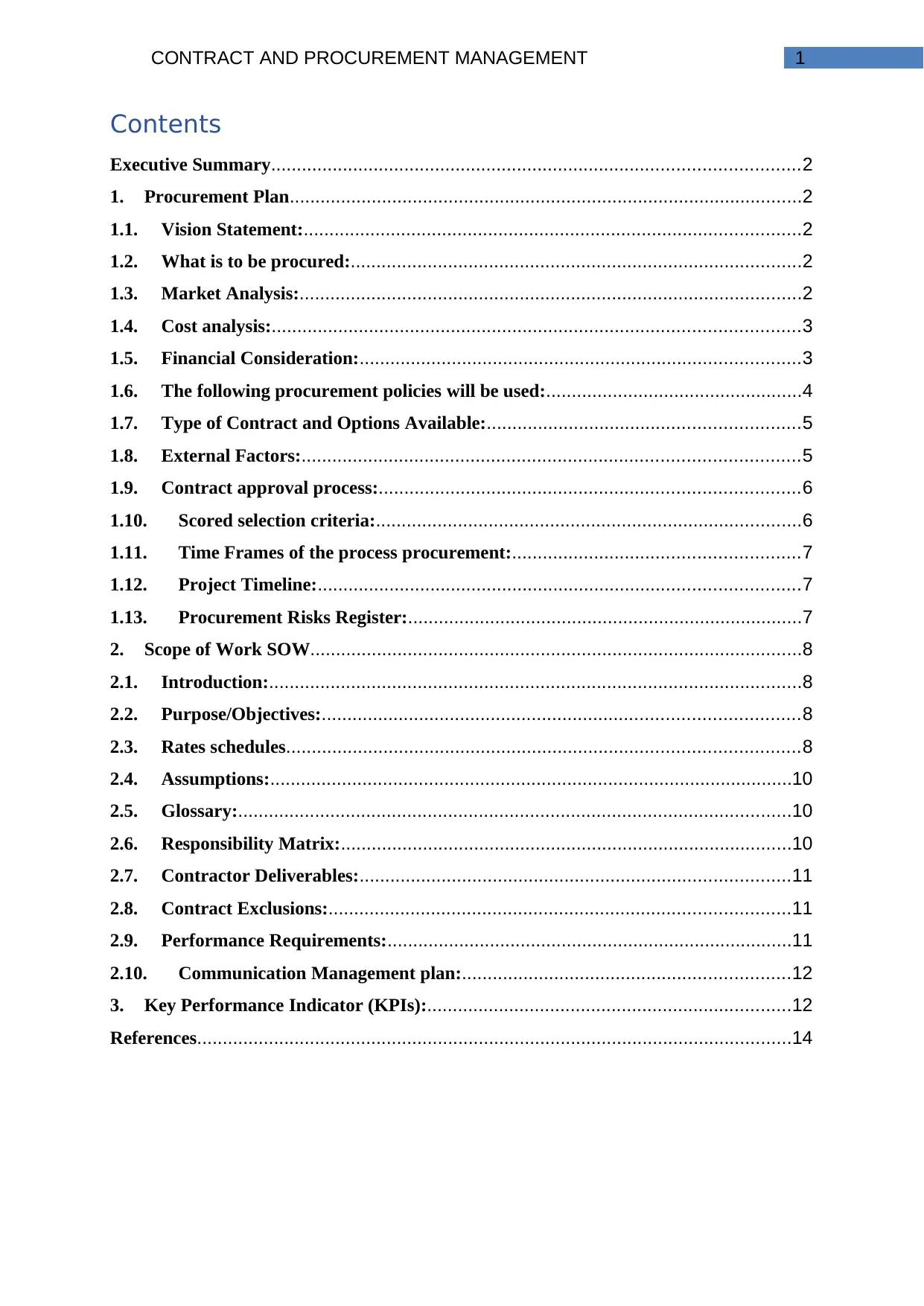
1CONTRACT AND PROCUREMENT MANAGEMENT
Contents
Executive Summary.......................................................................................................2
1. Procurement Plan....................................................................................................2
1.1. Vision Statement:.................................................................................................2
1.2. What is to be procured:........................................................................................2
1.3. Market Analysis:..................................................................................................2
1.4. Cost analysis:.......................................................................................................3
1.5. Financial Consideration:......................................................................................3
1.6. The following procurement policies will be used:..................................................4
1.7. Type of Contract and Options Available:.............................................................5
1.8. External Factors:.................................................................................................5
1.9. Contract approval process:..................................................................................6
1.10. Scored selection criteria:...................................................................................6
1.11. Time Frames of the process procurement:........................................................7
1.12. Project Timeline:..............................................................................................7
1.13. Procurement Risks Register:.............................................................................7
2. Scope of Work SOW................................................................................................8
2.1. Introduction:........................................................................................................8
2.2. Purpose/Objectives:.............................................................................................8
2.3. Rates schedules....................................................................................................8
2.4. Assumptions:......................................................................................................10
2.5. Glossary:............................................................................................................10
2.6. Responsibility Matrix:........................................................................................10
2.7. Contractor Deliverables:....................................................................................11
2.8. Contract Exclusions:..........................................................................................11
2.9. Performance Requirements:...............................................................................11
2.10. Communication Management plan:................................................................12
3. Key Performance Indicator (KPIs):.......................................................................12
References....................................................................................................................14
Contents
Executive Summary.......................................................................................................2
1. Procurement Plan....................................................................................................2
1.1. Vision Statement:.................................................................................................2
1.2. What is to be procured:........................................................................................2
1.3. Market Analysis:..................................................................................................2
1.4. Cost analysis:.......................................................................................................3
1.5. Financial Consideration:......................................................................................3
1.6. The following procurement policies will be used:..................................................4
1.7. Type of Contract and Options Available:.............................................................5
1.8. External Factors:.................................................................................................5
1.9. Contract approval process:..................................................................................6
1.10. Scored selection criteria:...................................................................................6
1.11. Time Frames of the process procurement:........................................................7
1.12. Project Timeline:..............................................................................................7
1.13. Procurement Risks Register:.............................................................................7
2. Scope of Work SOW................................................................................................8
2.1. Introduction:........................................................................................................8
2.2. Purpose/Objectives:.............................................................................................8
2.3. Rates schedules....................................................................................................8
2.4. Assumptions:......................................................................................................10
2.5. Glossary:............................................................................................................10
2.6. Responsibility Matrix:........................................................................................10
2.7. Contractor Deliverables:....................................................................................11
2.8. Contract Exclusions:..........................................................................................11
2.9. Performance Requirements:...............................................................................11
2.10. Communication Management plan:................................................................12
3. Key Performance Indicator (KPIs):.......................................................................12
References....................................................................................................................14
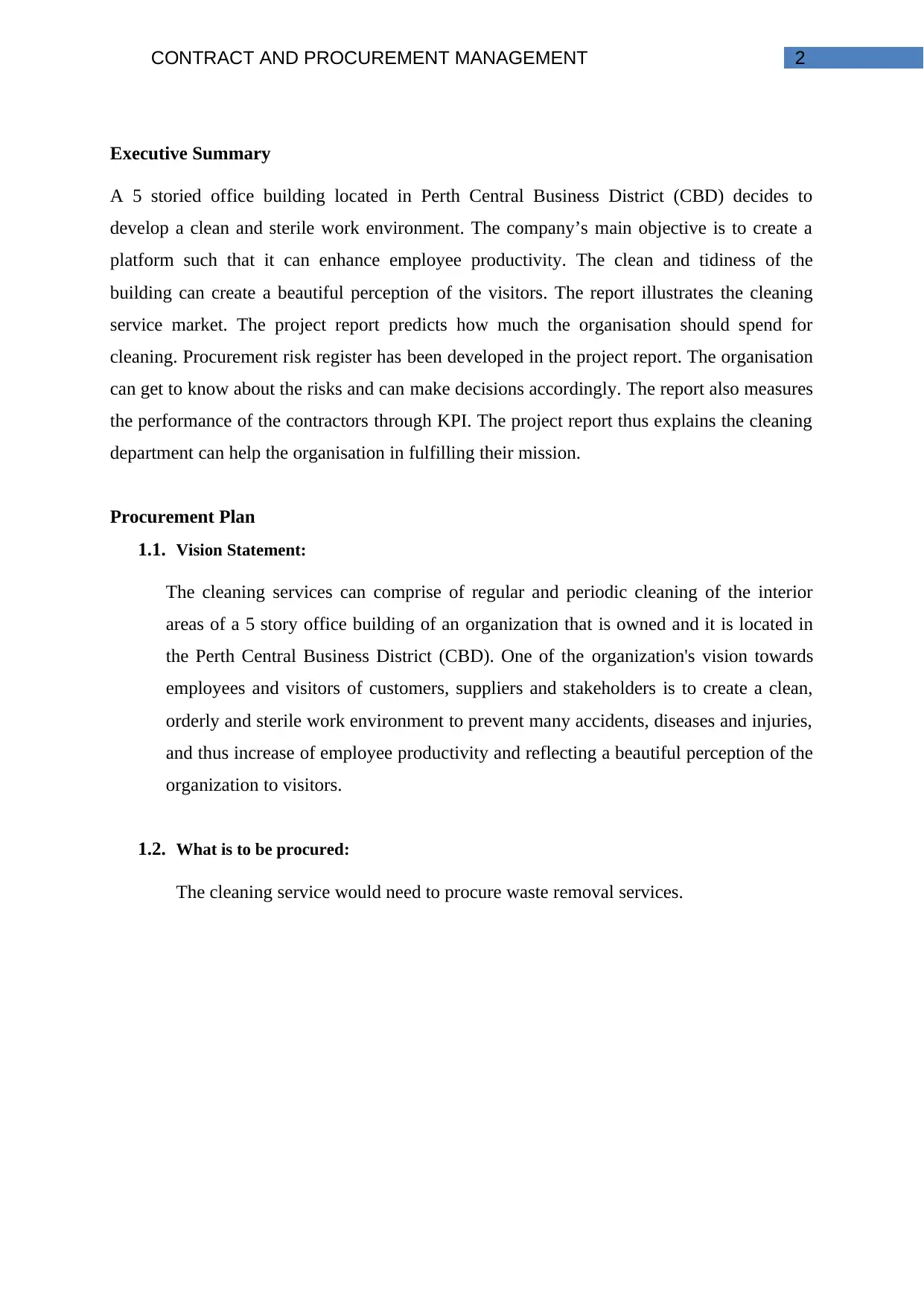
2CONTRACT AND PROCUREMENT MANAGEMENT
Executive Summary
A 5 storied office building located in Perth Central Business District (CBD) decides to
develop a clean and sterile work environment. The company’s main objective is to create a
platform such that it can enhance employee productivity. The clean and tidiness of the
building can create a beautiful perception of the visitors. The report illustrates the cleaning
service market. The project report predicts how much the organisation should spend for
cleaning. Procurement risk register has been developed in the project report. The organisation
can get to know about the risks and can make decisions accordingly. The report also measures
the performance of the contractors through KPI. The project report thus explains the cleaning
department can help the organisation in fulfilling their mission.
Procurement Plan
1.1. Vision Statement:
The cleaning services can comprise of regular and periodic cleaning of the interior
areas of a 5 story office building of an organization that is owned and it is located in
the Perth Central Business District (CBD). One of the organization's vision towards
employees and visitors of customers, suppliers and stakeholders is to create a clean,
orderly and sterile work environment to prevent many accidents, diseases and injuries,
and thus increase of employee productivity and reflecting a beautiful perception of the
organization to visitors.
1.2. What is to be procured:
The cleaning service would need to procure waste removal services.
Executive Summary
A 5 storied office building located in Perth Central Business District (CBD) decides to
develop a clean and sterile work environment. The company’s main objective is to create a
platform such that it can enhance employee productivity. The clean and tidiness of the
building can create a beautiful perception of the visitors. The report illustrates the cleaning
service market. The project report predicts how much the organisation should spend for
cleaning. Procurement risk register has been developed in the project report. The organisation
can get to know about the risks and can make decisions accordingly. The report also measures
the performance of the contractors through KPI. The project report thus explains the cleaning
department can help the organisation in fulfilling their mission.
Procurement Plan
1.1. Vision Statement:
The cleaning services can comprise of regular and periodic cleaning of the interior
areas of a 5 story office building of an organization that is owned and it is located in
the Perth Central Business District (CBD). One of the organization's vision towards
employees and visitors of customers, suppliers and stakeholders is to create a clean,
orderly and sterile work environment to prevent many accidents, diseases and injuries,
and thus increase of employee productivity and reflecting a beautiful perception of the
organization to visitors.
1.2. What is to be procured:
The cleaning service would need to procure waste removal services.
⊘ This is a preview!⊘
Do you want full access?
Subscribe today to unlock all pages.

Trusted by 1+ million students worldwide
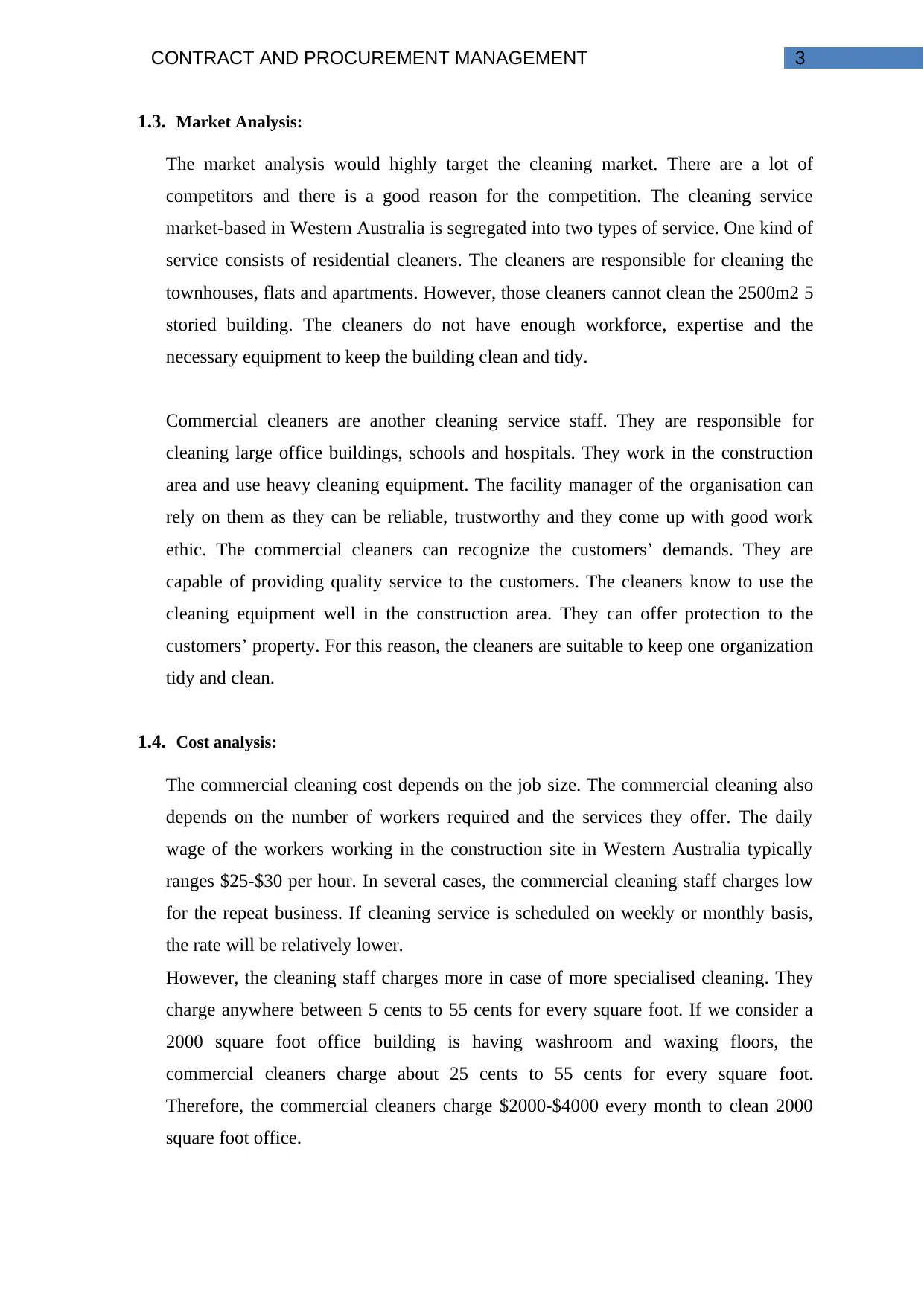
3CONTRACT AND PROCUREMENT MANAGEMENT
1.3. Market Analysis:
The market analysis would highly target the cleaning market. There are a lot of
competitors and there is a good reason for the competition. The cleaning service
market-based in Western Australia is segregated into two types of service. One kind of
service consists of residential cleaners. The cleaners are responsible for cleaning the
townhouses, flats and apartments. However, those cleaners cannot clean the 2500m2 5
storied building. The cleaners do not have enough workforce, expertise and the
necessary equipment to keep the building clean and tidy.
Commercial cleaners are another cleaning service staff. They are responsible for
cleaning large office buildings, schools and hospitals. They work in the construction
area and use heavy cleaning equipment. The facility manager of the organisation can
rely on them as they can be reliable, trustworthy and they come up with good work
ethic. The commercial cleaners can recognize the customers’ demands. They are
capable of providing quality service to the customers. The cleaners know to use the
cleaning equipment well in the construction area. They can offer protection to the
customers’ property. For this reason, the cleaners are suitable to keep one organization
tidy and clean.
1.4. Cost analysis:
The commercial cleaning cost depends on the job size. The commercial cleaning also
depends on the number of workers required and the services they offer. The daily
wage of the workers working in the construction site in Western Australia typically
ranges $25-$30 per hour. In several cases, the commercial cleaning staff charges low
for the repeat business. If cleaning service is scheduled on weekly or monthly basis,
the rate will be relatively lower.
However, the cleaning staff charges more in case of more specialised cleaning. They
charge anywhere between 5 cents to 55 cents for every square foot. If we consider a
2000 square foot office building is having washroom and waxing floors, the
commercial cleaners charge about 25 cents to 55 cents for every square foot.
Therefore, the commercial cleaners charge $2000-$4000 every month to clean 2000
square foot office.
1.3. Market Analysis:
The market analysis would highly target the cleaning market. There are a lot of
competitors and there is a good reason for the competition. The cleaning service
market-based in Western Australia is segregated into two types of service. One kind of
service consists of residential cleaners. The cleaners are responsible for cleaning the
townhouses, flats and apartments. However, those cleaners cannot clean the 2500m2 5
storied building. The cleaners do not have enough workforce, expertise and the
necessary equipment to keep the building clean and tidy.
Commercial cleaners are another cleaning service staff. They are responsible for
cleaning large office buildings, schools and hospitals. They work in the construction
area and use heavy cleaning equipment. The facility manager of the organisation can
rely on them as they can be reliable, trustworthy and they come up with good work
ethic. The commercial cleaners can recognize the customers’ demands. They are
capable of providing quality service to the customers. The cleaners know to use the
cleaning equipment well in the construction area. They can offer protection to the
customers’ property. For this reason, the cleaners are suitable to keep one organization
tidy and clean.
1.4. Cost analysis:
The commercial cleaning cost depends on the job size. The commercial cleaning also
depends on the number of workers required and the services they offer. The daily
wage of the workers working in the construction site in Western Australia typically
ranges $25-$30 per hour. In several cases, the commercial cleaning staff charges low
for the repeat business. If cleaning service is scheduled on weekly or monthly basis,
the rate will be relatively lower.
However, the cleaning staff charges more in case of more specialised cleaning. They
charge anywhere between 5 cents to 55 cents for every square foot. If we consider a
2000 square foot office building is having washroom and waxing floors, the
commercial cleaners charge about 25 cents to 55 cents for every square foot.
Therefore, the commercial cleaners charge $2000-$4000 every month to clean 2000
square foot office.
Paraphrase This Document
Need a fresh take? Get an instant paraphrase of this document with our AI Paraphraser
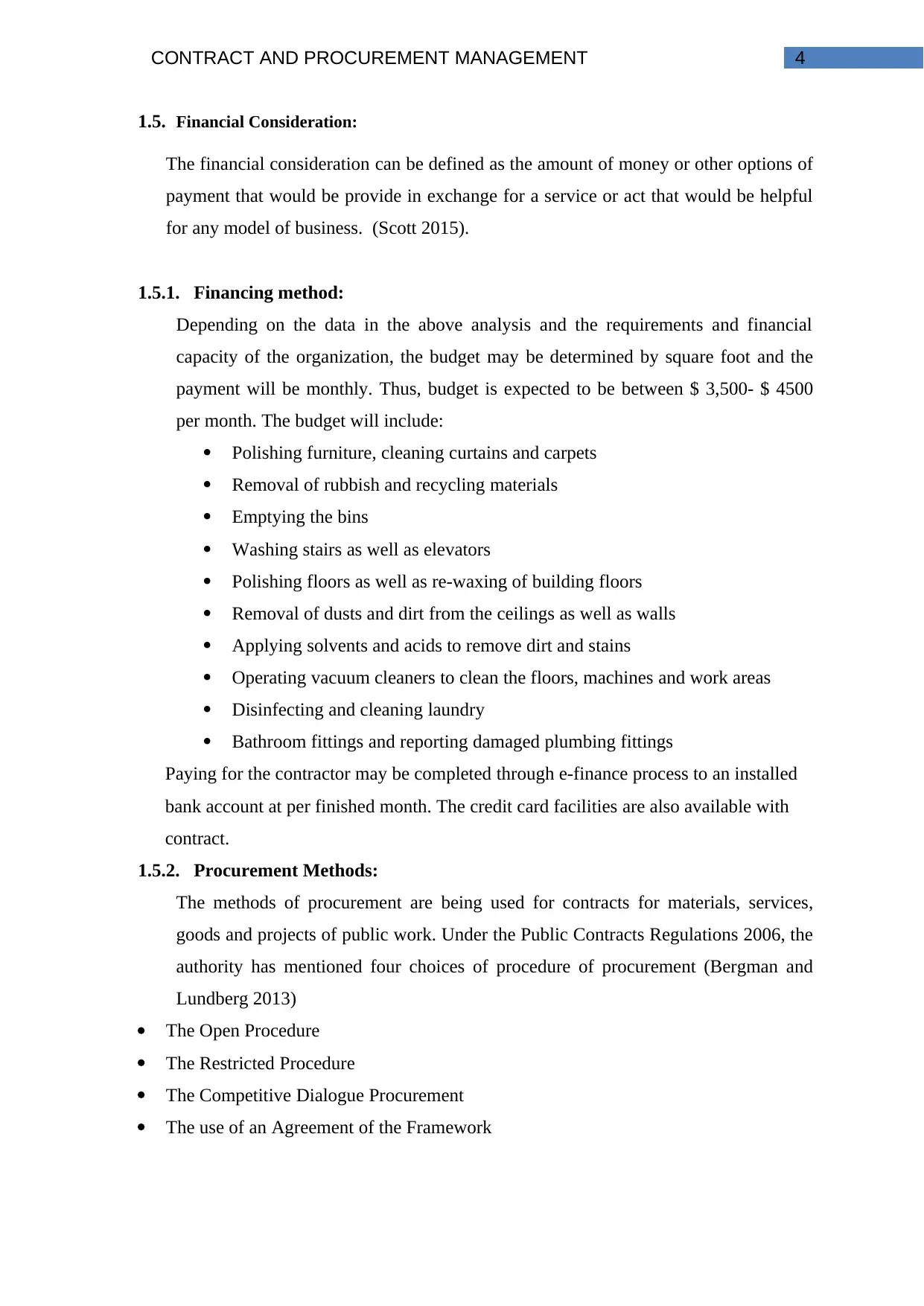
4CONTRACT AND PROCUREMENT MANAGEMENT
1.5. Financial Consideration:
The financial consideration can be defined as the amount of money or other options of
payment that would be provide in exchange for a service or act that would be helpful
for any model of business. (Scott 2015).
1.5.1. Financing method:
Depending on the data in the above analysis and the requirements and financial
capacity of the organization, the budget may be determined by square foot and the
payment will be monthly. Thus, budget is expected to be between $ 3,500- $ 4500
per month. The budget will include:
Polishing furniture, cleaning curtains and carpets
Removal of rubbish and recycling materials
Emptying the bins
Washing stairs as well as elevators
Polishing floors as well as re-waxing of building floors
Removal of dusts and dirt from the ceilings as well as walls
Applying solvents and acids to remove dirt and stains
Operating vacuum cleaners to clean the floors, machines and work areas
Disinfecting and cleaning laundry
Bathroom fittings and reporting damaged plumbing fittings
Paying for the contractor may be completed through e-finance process to an installed
bank account at per finished month. The credit card facilities are also available with
contract.
1.5.2. Procurement Methods:
The methods of procurement are being used for contracts for materials, services,
goods and projects of public work. Under the Public Contracts Regulations 2006, the
authority has mentioned four choices of procedure of procurement (Bergman and
Lundberg 2013)
The Open Procedure
The Restricted Procedure
The Competitive Dialogue Procurement
The use of an Agreement of the Framework
1.5. Financial Consideration:
The financial consideration can be defined as the amount of money or other options of
payment that would be provide in exchange for a service or act that would be helpful
for any model of business. (Scott 2015).
1.5.1. Financing method:
Depending on the data in the above analysis and the requirements and financial
capacity of the organization, the budget may be determined by square foot and the
payment will be monthly. Thus, budget is expected to be between $ 3,500- $ 4500
per month. The budget will include:
Polishing furniture, cleaning curtains and carpets
Removal of rubbish and recycling materials
Emptying the bins
Washing stairs as well as elevators
Polishing floors as well as re-waxing of building floors
Removal of dusts and dirt from the ceilings as well as walls
Applying solvents and acids to remove dirt and stains
Operating vacuum cleaners to clean the floors, machines and work areas
Disinfecting and cleaning laundry
Bathroom fittings and reporting damaged plumbing fittings
Paying for the contractor may be completed through e-finance process to an installed
bank account at per finished month. The credit card facilities are also available with
contract.
1.5.2. Procurement Methods:
The methods of procurement are being used for contracts for materials, services,
goods and projects of public work. Under the Public Contracts Regulations 2006, the
authority has mentioned four choices of procedure of procurement (Bergman and
Lundberg 2013)
The Open Procedure
The Restricted Procedure
The Competitive Dialogue Procurement
The use of an Agreement of the Framework
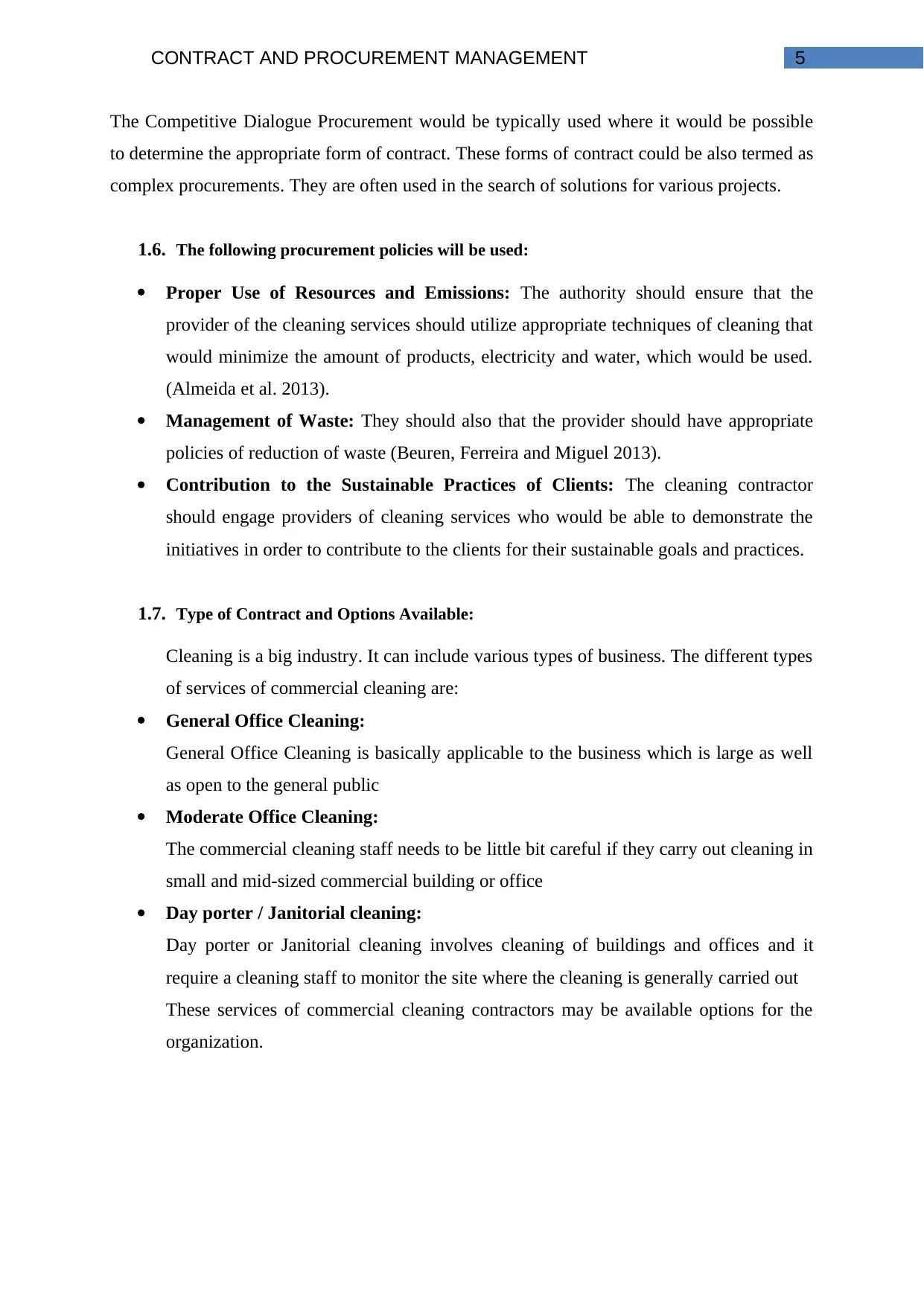
5CONTRACT AND PROCUREMENT MANAGEMENT
The Competitive Dialogue Procurement would be typically used where it would be possible
to determine the appropriate form of contract. These forms of contract could be also termed as
complex procurements. They are often used in the search of solutions for various projects.
1.6. The following procurement policies will be used:
Proper Use of Resources and Emissions: The authority should ensure that the
provider of the cleaning services should utilize appropriate techniques of cleaning that
would minimize the amount of products, electricity and water, which would be used.
(Almeida et al. 2013).
Management of Waste: They should also that the provider should have appropriate
policies of reduction of waste (Beuren, Ferreira and Miguel 2013).
Contribution to the Sustainable Practices of Clients: The cleaning contractor
should engage providers of cleaning services who would be able to demonstrate the
initiatives in order to contribute to the clients for their sustainable goals and practices.
1.7. Type of Contract and Options Available:
Cleaning is a big industry. It can include various types of business. The different types
of services of commercial cleaning are:
General Office Cleaning:
General Office Cleaning is basically applicable to the business which is large as well
as open to the general public
Moderate Office Cleaning:
The commercial cleaning staff needs to be little bit careful if they carry out cleaning in
small and mid-sized commercial building or office
Day porter / Janitorial cleaning:
Day porter or Janitorial cleaning involves cleaning of buildings and offices and it
require a cleaning staff to monitor the site where the cleaning is generally carried out
These services of commercial cleaning contractors may be available options for the
organization.
The Competitive Dialogue Procurement would be typically used where it would be possible
to determine the appropriate form of contract. These forms of contract could be also termed as
complex procurements. They are often used in the search of solutions for various projects.
1.6. The following procurement policies will be used:
Proper Use of Resources and Emissions: The authority should ensure that the
provider of the cleaning services should utilize appropriate techniques of cleaning that
would minimize the amount of products, electricity and water, which would be used.
(Almeida et al. 2013).
Management of Waste: They should also that the provider should have appropriate
policies of reduction of waste (Beuren, Ferreira and Miguel 2013).
Contribution to the Sustainable Practices of Clients: The cleaning contractor
should engage providers of cleaning services who would be able to demonstrate the
initiatives in order to contribute to the clients for their sustainable goals and practices.
1.7. Type of Contract and Options Available:
Cleaning is a big industry. It can include various types of business. The different types
of services of commercial cleaning are:
General Office Cleaning:
General Office Cleaning is basically applicable to the business which is large as well
as open to the general public
Moderate Office Cleaning:
The commercial cleaning staff needs to be little bit careful if they carry out cleaning in
small and mid-sized commercial building or office
Day porter / Janitorial cleaning:
Day porter or Janitorial cleaning involves cleaning of buildings and offices and it
require a cleaning staff to monitor the site where the cleaning is generally carried out
These services of commercial cleaning contractors may be available options for the
organization.
⊘ This is a preview!⊘
Do you want full access?
Subscribe today to unlock all pages.

Trusted by 1+ million students worldwide
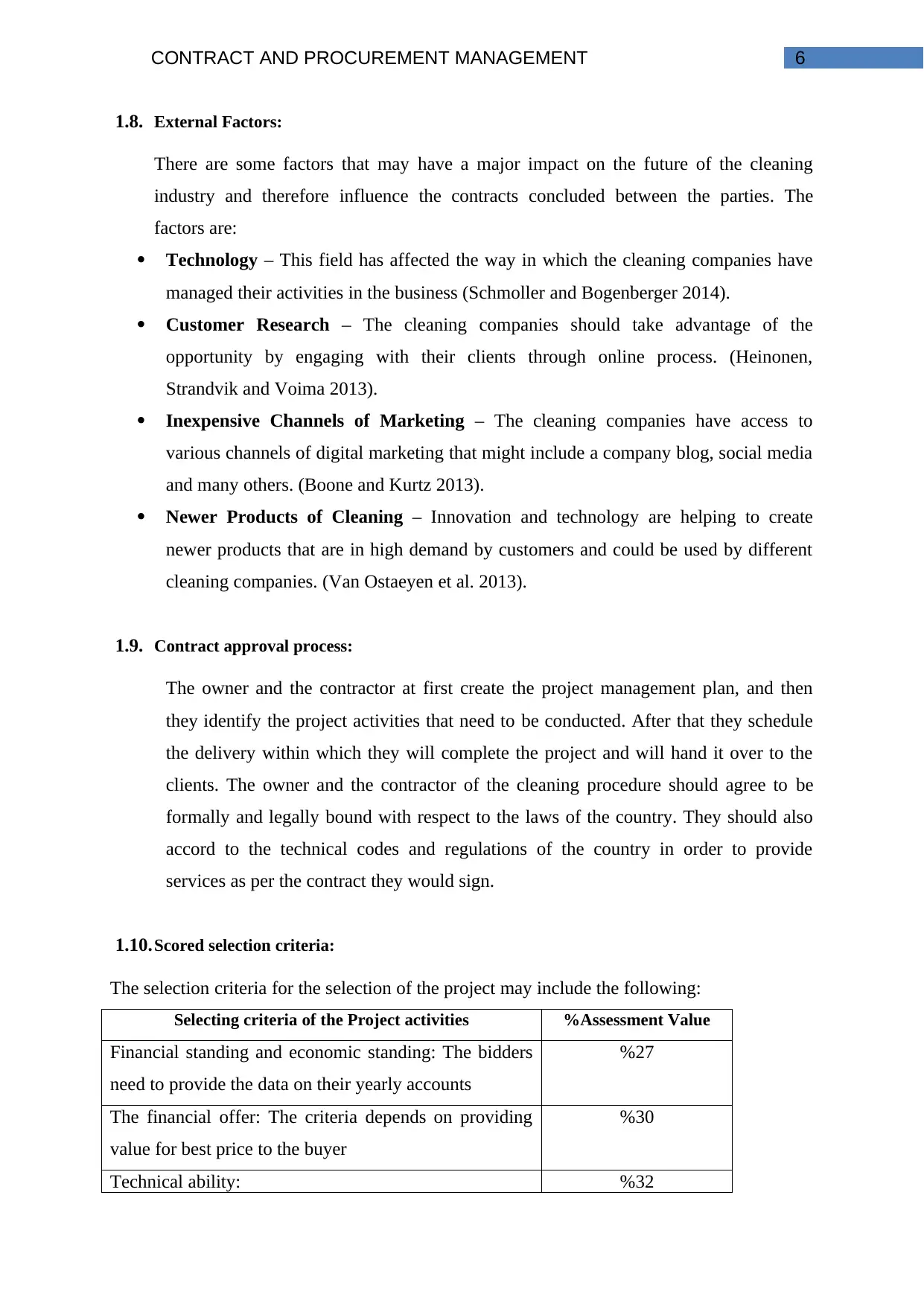
6CONTRACT AND PROCUREMENT MANAGEMENT
1.8. External Factors:
There are some factors that may have a major impact on the future of the cleaning
industry and therefore influence the contracts concluded between the parties. The
factors are:
Technology – This field has affected the way in which the cleaning companies have
managed their activities in the business (Schmoller and Bogenberger 2014).
Customer Research – The cleaning companies should take advantage of the
opportunity by engaging with their clients through online process. (Heinonen,
Strandvik and Voima 2013).
Inexpensive Channels of Marketing – The cleaning companies have access to
various channels of digital marketing that might include a company blog, social media
and many others. (Boone and Kurtz 2013).
Newer Products of Cleaning – Innovation and technology are helping to create
newer products that are in high demand by customers and could be used by different
cleaning companies. (Van Ostaeyen et al. 2013).
1.9. Contract approval process:
The owner and the contractor at first create the project management plan, and then
they identify the project activities that need to be conducted. After that they schedule
the delivery within which they will complete the project and will hand it over to the
clients. The owner and the contractor of the cleaning procedure should agree to be
formally and legally bound with respect to the laws of the country. They should also
accord to the technical codes and regulations of the country in order to provide
services as per the contract they would sign.
1.10.Scored selection criteria:
The selection criteria for the selection of the project may include the following:
Selecting criteria of the Project activities %Assessment Value
Financial standing and economic standing: The bidders
need to provide the data on their yearly accounts
%27
The financial offer: The criteria depends on providing
value for best price to the buyer
%30
Technical ability: %32
1.8. External Factors:
There are some factors that may have a major impact on the future of the cleaning
industry and therefore influence the contracts concluded between the parties. The
factors are:
Technology – This field has affected the way in which the cleaning companies have
managed their activities in the business (Schmoller and Bogenberger 2014).
Customer Research – The cleaning companies should take advantage of the
opportunity by engaging with their clients through online process. (Heinonen,
Strandvik and Voima 2013).
Inexpensive Channels of Marketing – The cleaning companies have access to
various channels of digital marketing that might include a company blog, social media
and many others. (Boone and Kurtz 2013).
Newer Products of Cleaning – Innovation and technology are helping to create
newer products that are in high demand by customers and could be used by different
cleaning companies. (Van Ostaeyen et al. 2013).
1.9. Contract approval process:
The owner and the contractor at first create the project management plan, and then
they identify the project activities that need to be conducted. After that they schedule
the delivery within which they will complete the project and will hand it over to the
clients. The owner and the contractor of the cleaning procedure should agree to be
formally and legally bound with respect to the laws of the country. They should also
accord to the technical codes and regulations of the country in order to provide
services as per the contract they would sign.
1.10.Scored selection criteria:
The selection criteria for the selection of the project may include the following:
Selecting criteria of the Project activities %Assessment Value
Financial standing and economic standing: The bidders
need to provide the data on their yearly accounts
%27
The financial offer: The criteria depends on providing
value for best price to the buyer
%30
Technical ability: %32
Paraphrase This Document
Need a fresh take? Get an instant paraphrase of this document with our AI Paraphraser
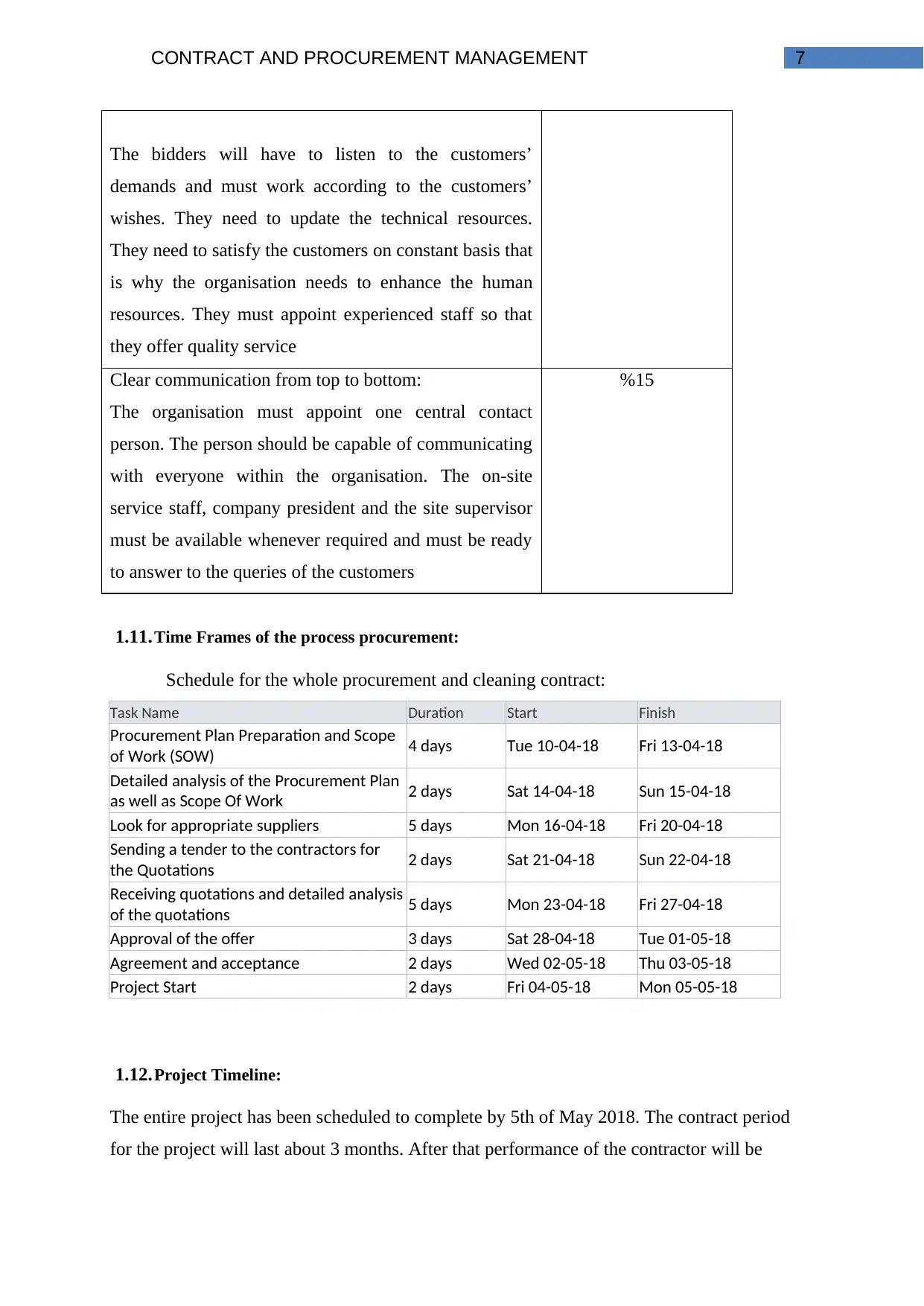
7CONTRACT AND PROCUREMENT MANAGEMENT
The bidders will have to listen to the customers’
demands and must work according to the customers’
wishes. They need to update the technical resources.
They need to satisfy the customers on constant basis that
is why the organisation needs to enhance the human
resources. They must appoint experienced staff so that
they offer quality service
Clear communication from top to bottom:
The organisation must appoint one central contact
person. The person should be capable of communicating
with everyone within the organisation. The on-site
service staff, company president and the site supervisor
must be available whenever required and must be ready
to answer to the queries of the customers
%15
1.11.Time Frames of the process procurement:
Schedule for the whole procurement and cleaning contract:
Task Name Duration Start Finish
Procurement Plan Preparation and Scope
of Work (SOW) 4 days Tue 10-04-18 Fri 13-04-18
Detailed analysis of the Procurement Plan
as well as Scope Of Work 2 days Sat 14-04-18 Sun 15-04-18
Look for appropriate suppliers 5 days Mon 16-04-18 Fri 20-04-18
Sending a tender to the contractors for
the Quotations 2 days Sat 21-04-18 Sun 22-04-18
Receiving quotations and detailed analysis
of the quotations 5 days Mon 23-04-18 Fri 27-04-18
Approval of the offer 3 days Sat 28-04-18 Tue 01-05-18
Agreement and acceptance 2 days Wed 02-05-18 Thu 03-05-18
Project Start 2 days Fri 04-05-18 Mon 05-05-18
1.12.Project Timeline:
The entire project has been scheduled to complete by 5th of May 2018. The contract period
for the project will last about 3 months. After that performance of the contractor will be
The bidders will have to listen to the customers’
demands and must work according to the customers’
wishes. They need to update the technical resources.
They need to satisfy the customers on constant basis that
is why the organisation needs to enhance the human
resources. They must appoint experienced staff so that
they offer quality service
Clear communication from top to bottom:
The organisation must appoint one central contact
person. The person should be capable of communicating
with everyone within the organisation. The on-site
service staff, company president and the site supervisor
must be available whenever required and must be ready
to answer to the queries of the customers
%15
1.11.Time Frames of the process procurement:
Schedule for the whole procurement and cleaning contract:
Task Name Duration Start Finish
Procurement Plan Preparation and Scope
of Work (SOW) 4 days Tue 10-04-18 Fri 13-04-18
Detailed analysis of the Procurement Plan
as well as Scope Of Work 2 days Sat 14-04-18 Sun 15-04-18
Look for appropriate suppliers 5 days Mon 16-04-18 Fri 20-04-18
Sending a tender to the contractors for
the Quotations 2 days Sat 21-04-18 Sun 22-04-18
Receiving quotations and detailed analysis
of the quotations 5 days Mon 23-04-18 Fri 27-04-18
Approval of the offer 3 days Sat 28-04-18 Tue 01-05-18
Agreement and acceptance 2 days Wed 02-05-18 Thu 03-05-18
Project Start 2 days Fri 04-05-18 Mon 05-05-18
1.12.Project Timeline:
The entire project has been scheduled to complete by 5th of May 2018. The contract period
for the project will last about 3 months. After that performance of the contractor will be
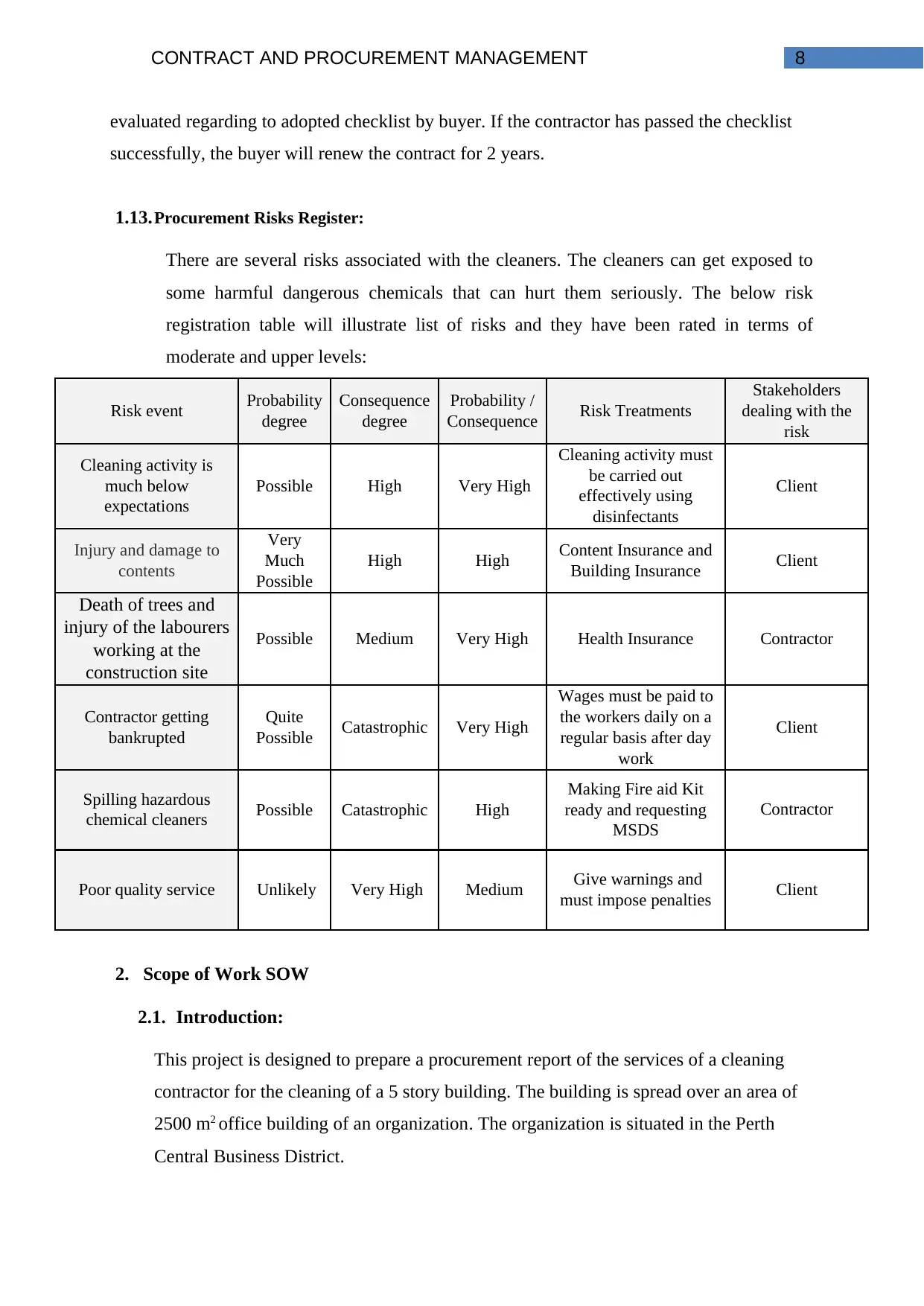
8CONTRACT AND PROCUREMENT MANAGEMENT
evaluated regarding to adopted checklist by buyer. If the contractor has passed the checklist
successfully, the buyer will renew the contract for 2 years.
1.13.Procurement Risks Register:
There are several risks associated with the cleaners. The cleaners can get exposed to
some harmful dangerous chemicals that can hurt them seriously. The below risk
registration table will illustrate list of risks and they have been rated in terms of
moderate and upper levels:
Risk event Probability
degree
Consequence
degree
Probability /
Consequence Risk Treatments
Stakeholders
dealing with the
risk
Cleaning activity is
much below
expectations
Possible High Very High
Cleaning activity must
be carried out
effectively using
disinfectants
Client
Injury and damage to
contents
Very
Much
Possible
High High Content Insurance and
Building Insurance Client
Death of trees and
injury of the labourers
working at the
construction site
Possible Medium Very High Health Insurance Contractor
Contractor getting
bankrupted
Quite
Possible Catastrophic Very High
Wages must be paid to
the workers daily on a
regular basis after day
work
Client
Spilling hazardous
chemical cleaners Possible Catastrophic High
Making Fire aid Kit
ready and requesting
MSDS
Contractor
Poor quality service Unlikely Very High Medium Give warnings and
must impose penalties Client
2. Scope of Work SOW
2.1. Introduction:
This project is designed to prepare a procurement report of the services of a cleaning
contractor for the cleaning of a 5 story building. The building is spread over an area of
2500 m2 office building of an organization. The organization is situated in the Perth
Central Business District.
evaluated regarding to adopted checklist by buyer. If the contractor has passed the checklist
successfully, the buyer will renew the contract for 2 years.
1.13.Procurement Risks Register:
There are several risks associated with the cleaners. The cleaners can get exposed to
some harmful dangerous chemicals that can hurt them seriously. The below risk
registration table will illustrate list of risks and they have been rated in terms of
moderate and upper levels:
Risk event Probability
degree
Consequence
degree
Probability /
Consequence Risk Treatments
Stakeholders
dealing with the
risk
Cleaning activity is
much below
expectations
Possible High Very High
Cleaning activity must
be carried out
effectively using
disinfectants
Client
Injury and damage to
contents
Very
Much
Possible
High High Content Insurance and
Building Insurance Client
Death of trees and
injury of the labourers
working at the
construction site
Possible Medium Very High Health Insurance Contractor
Contractor getting
bankrupted
Quite
Possible Catastrophic Very High
Wages must be paid to
the workers daily on a
regular basis after day
work
Client
Spilling hazardous
chemical cleaners Possible Catastrophic High
Making Fire aid Kit
ready and requesting
MSDS
Contractor
Poor quality service Unlikely Very High Medium Give warnings and
must impose penalties Client
2. Scope of Work SOW
2.1. Introduction:
This project is designed to prepare a procurement report of the services of a cleaning
contractor for the cleaning of a 5 story building. The building is spread over an area of
2500 m2 office building of an organization. The organization is situated in the Perth
Central Business District.
⊘ This is a preview!⊘
Do you want full access?
Subscribe today to unlock all pages.

Trusted by 1+ million students worldwide
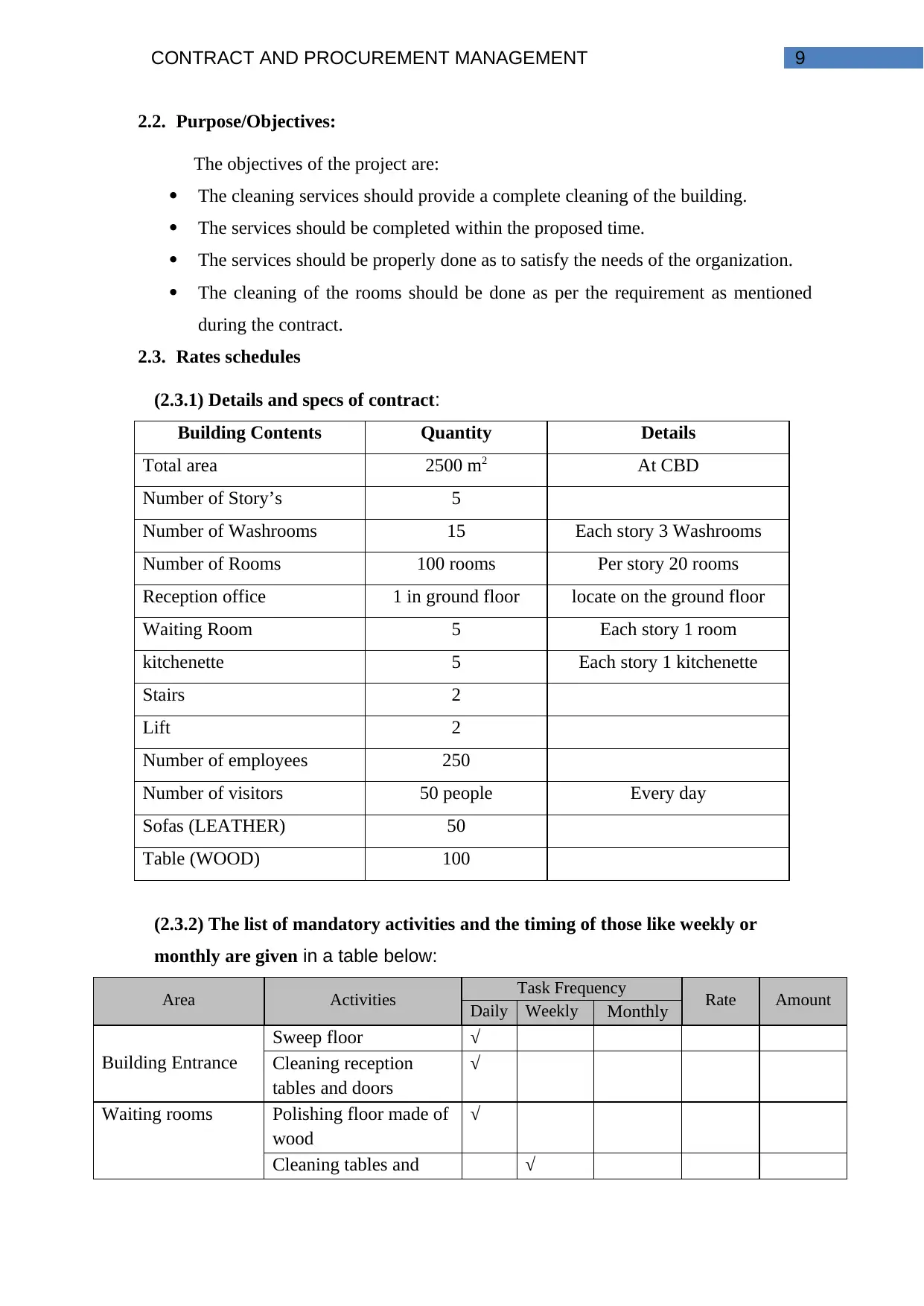
9CONTRACT AND PROCUREMENT MANAGEMENT
2.2. Purpose/Objectives:
The objectives of the project are:
The cleaning services should provide a complete cleaning of the building.
The services should be completed within the proposed time.
The services should be properly done as to satisfy the needs of the organization.
The cleaning of the rooms should be done as per the requirement as mentioned
during the contract.
2.3. Rates schedules
(2.3.1) Details and specs of contract:
Building Contents Quantity Details
Total area 2500 m2 At CBD
Number of Story’s 5
Number of Washrooms 15 Each story 3 Washrooms
Number of Rooms 100 rooms Per story 20 rooms
Reception office 1 in ground floor locate on the ground floor
Waiting Room 5 Each story 1 room
kitchenette 5 Each story 1 kitchenette
Stairs 2
Lift 2
Number of employees 250
Number of visitors 50 people Every day
Sofas (LEATHER) 50
Table (WOOD) 100
(2.3.2) The list of mandatory activities and the timing of those like weekly or
monthly are given in a table below:
Area Activities Task Frequency Rate Amount
Daily Weekly Monthly
Building Entrance
Sweep floor √
Cleaning reception
tables and doors
√
Waiting rooms Polishing floor made of
wood
√
Cleaning tables and √
2.2. Purpose/Objectives:
The objectives of the project are:
The cleaning services should provide a complete cleaning of the building.
The services should be completed within the proposed time.
The services should be properly done as to satisfy the needs of the organization.
The cleaning of the rooms should be done as per the requirement as mentioned
during the contract.
2.3. Rates schedules
(2.3.1) Details and specs of contract:
Building Contents Quantity Details
Total area 2500 m2 At CBD
Number of Story’s 5
Number of Washrooms 15 Each story 3 Washrooms
Number of Rooms 100 rooms Per story 20 rooms
Reception office 1 in ground floor locate on the ground floor
Waiting Room 5 Each story 1 room
kitchenette 5 Each story 1 kitchenette
Stairs 2
Lift 2
Number of employees 250
Number of visitors 50 people Every day
Sofas (LEATHER) 50
Table (WOOD) 100
(2.3.2) The list of mandatory activities and the timing of those like weekly or
monthly are given in a table below:
Area Activities Task Frequency Rate Amount
Daily Weekly Monthly
Building Entrance
Sweep floor √
Cleaning reception
tables and doors
√
Waiting rooms Polishing floor made of
wood
√
Cleaning tables and √
Paraphrase This Document
Need a fresh take? Get an instant paraphrase of this document with our AI Paraphraser
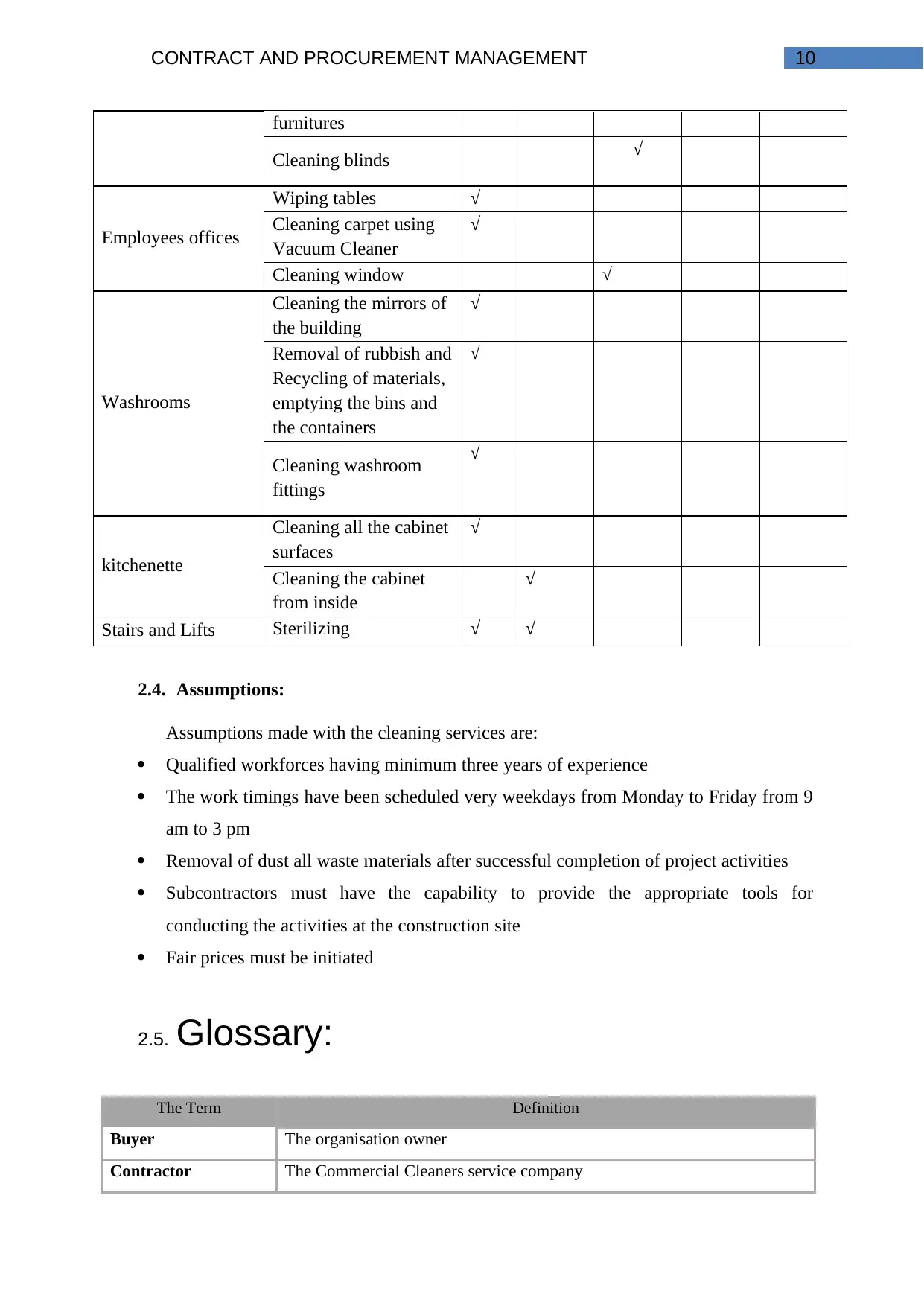
10CONTRACT AND PROCUREMENT MANAGEMENT
furnitures
Cleaning blinds √
Employees offices
Wiping tables √
Cleaning carpet using
Vacuum Cleaner
√
Cleaning window √
Washrooms
Cleaning the mirrors of
the building
√
Removal of rubbish and
Recycling of materials,
emptying the bins and
the containers
√
Cleaning washroom
fittings
√
kitchenette
Cleaning all the cabinet
surfaces
√
Cleaning the cabinet
from inside
√
Stairs and Lifts Sterilizing √ √
2.4. Assumptions:
Assumptions made with the cleaning services are:
Qualified workforces having minimum three years of experience
The work timings have been scheduled very weekdays from Monday to Friday from 9
am to 3 pm
Removal of dust all waste materials after successful completion of project activities
Subcontractors must have the capability to provide the appropriate tools for
conducting the activities at the construction site
Fair prices must be initiated
2.5. Glossary:
The Term Definition
Buyer The organisation owner
Contractor The Commercial Cleaners service company
furnitures
Cleaning blinds √
Employees offices
Wiping tables √
Cleaning carpet using
Vacuum Cleaner
√
Cleaning window √
Washrooms
Cleaning the mirrors of
the building
√
Removal of rubbish and
Recycling of materials,
emptying the bins and
the containers
√
Cleaning washroom
fittings
√
kitchenette
Cleaning all the cabinet
surfaces
√
Cleaning the cabinet
from inside
√
Stairs and Lifts Sterilizing √ √
2.4. Assumptions:
Assumptions made with the cleaning services are:
Qualified workforces having minimum three years of experience
The work timings have been scheduled very weekdays from Monday to Friday from 9
am to 3 pm
Removal of dust all waste materials after successful completion of project activities
Subcontractors must have the capability to provide the appropriate tools for
conducting the activities at the construction site
Fair prices must be initiated
2.5. Glossary:
The Term Definition
Buyer The organisation owner
Contractor The Commercial Cleaners service company
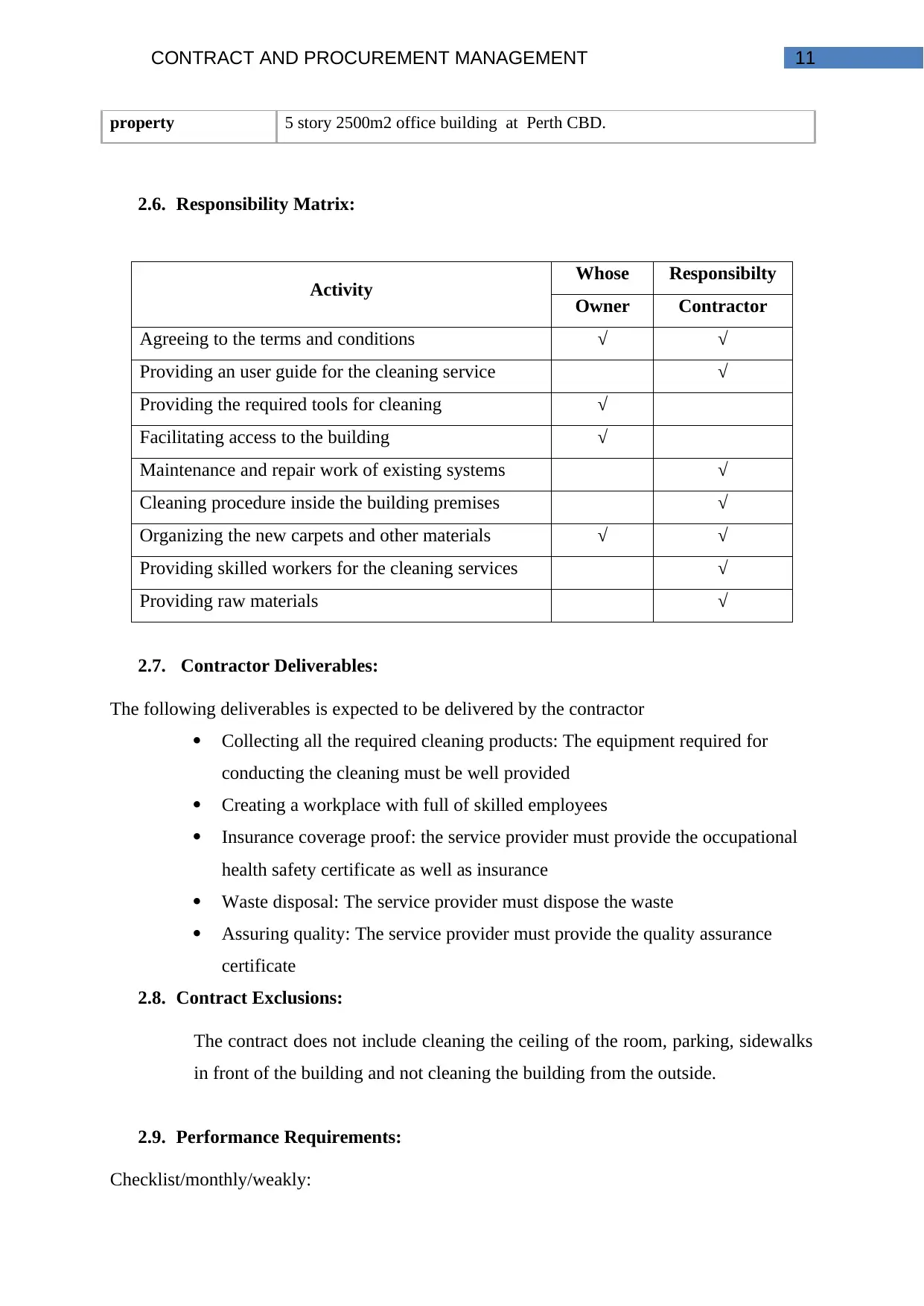
11CONTRACT AND PROCUREMENT MANAGEMENT
property 5 story 2500m2 office building at Perth CBD.
2.6. Responsibility Matrix:
Activity Whose Responsibilty
Owner Contractor
Agreeing to the terms and conditions √ √
Providing an user guide for the cleaning service √
Providing the required tools for cleaning √
Facilitating access to the building √
Maintenance and repair work of existing systems √
Cleaning procedure inside the building premises √
Organizing the new carpets and other materials √ √
Providing skilled workers for the cleaning services √
Providing raw materials √
2.7. Contractor Deliverables:
The following deliverables is expected to be delivered by the contractor
Collecting all the required cleaning products: The equipment required for
conducting the cleaning must be well provided
Creating a workplace with full of skilled employees
Insurance coverage proof: the service provider must provide the occupational
health safety certificate as well as insurance
Waste disposal: The service provider must dispose the waste
Assuring quality: The service provider must provide the quality assurance
certificate
2.8. Contract Exclusions:
The contract does not include cleaning the ceiling of the room, parking, sidewalks
in front of the building and not cleaning the building from the outside.
2.9. Performance Requirements:
Checklist/monthly/weakly:
property 5 story 2500m2 office building at Perth CBD.
2.6. Responsibility Matrix:
Activity Whose Responsibilty
Owner Contractor
Agreeing to the terms and conditions √ √
Providing an user guide for the cleaning service √
Providing the required tools for cleaning √
Facilitating access to the building √
Maintenance and repair work of existing systems √
Cleaning procedure inside the building premises √
Organizing the new carpets and other materials √ √
Providing skilled workers for the cleaning services √
Providing raw materials √
2.7. Contractor Deliverables:
The following deliverables is expected to be delivered by the contractor
Collecting all the required cleaning products: The equipment required for
conducting the cleaning must be well provided
Creating a workplace with full of skilled employees
Insurance coverage proof: the service provider must provide the occupational
health safety certificate as well as insurance
Waste disposal: The service provider must dispose the waste
Assuring quality: The service provider must provide the quality assurance
certificate
2.8. Contract Exclusions:
The contract does not include cleaning the ceiling of the room, parking, sidewalks
in front of the building and not cleaning the building from the outside.
2.9. Performance Requirements:
Checklist/monthly/weakly:
⊘ This is a preview!⊘
Do you want full access?
Subscribe today to unlock all pages.

Trusted by 1+ million students worldwide
1 out of 18
Your All-in-One AI-Powered Toolkit for Academic Success.
+13062052269
info@desklib.com
Available 24*7 on WhatsApp / Email
![[object Object]](/_next/static/media/star-bottom.7253800d.svg)
Unlock your academic potential
Copyright © 2020–2025 A2Z Services. All Rights Reserved. Developed and managed by ZUCOL.

